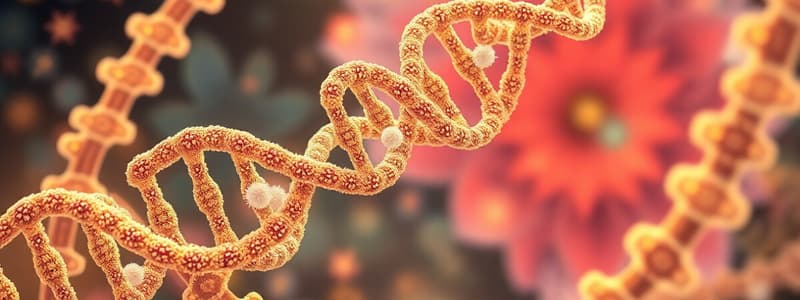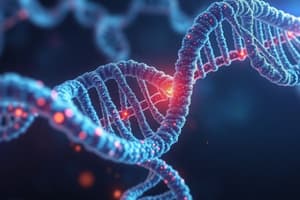Podcast
Questions and Answers
What was the main objective of the Human Genome Project?
What was the main objective of the Human Genome Project?
- To determine the complete sequence of human DNA. (correct)
- To identify all the proteins found in the human body.
- To develop new techniques for sequencing DNA.
- To understand the evolution of human genes.
What is the significance of "Open Reading Frames" (ORFs) in gene identification?
What is the significance of "Open Reading Frames" (ORFs) in gene identification?
- ORFs are regions of DNA that code for specific amino acids, indicating potential protein-coding genes. (correct)
- ORFs are repetitive sequences of DNA that have no known function.
- ORFs are sequences of DNA that are highly conserved across different species.
- ORFs are non-coding regions of DNA that regulate gene expression.
Which of the following is NOT a key step in the DNA typing process?
Which of the following is NOT a key step in the DNA typing process?
- Extraction of DNA from samples obtained from blood, hair, or saliva.
- Amplification of the extracted DNA using polymerase chain reaction (PCR).
- Comparison of DNA fragment patterns between known sources and suspects to identify matches.
- Sequencing the entire genome to identify unique regions. (correct)
- Separation and analysis of DNA fragments using electrophoresis with different markers.
Why is DNA typing preferred over DNA fingerprinting by forensic scientists?
Why is DNA typing preferred over DNA fingerprinting by forensic scientists?
What is the primary function of the non-coding regions in the human genome?
What is the primary function of the non-coding regions in the human genome?
How do scientists use the genomic information of other organisms, such as fruit flies and bacteria, to understand the human genome?
How do scientists use the genomic information of other organisms, such as fruit flies and bacteria, to understand the human genome?
What is the significance of the "long stretches of repeated sequences" found in the human genome, which are also known as non-coding sequences?
What is the significance of the "long stretches of repeated sequences" found in the human genome, which are also known as non-coding sequences?
Which of the following accurately describes the field of bioinformatics?
Which of the following accurately describes the field of bioinformatics?
How do scientists use the information from the Human Genome Project to advance the field of medicine and treatment?
How do scientists use the information from the Human Genome Project to advance the field of medicine and treatment?
What technique is used to amplify the small amount of DNA extracted from samples for DNA typing?
What technique is used to amplify the small amount of DNA extracted from samples for DNA typing?
Which of the following is NOT a reason why the DNA typing technique is considered a robust method in forensics?
Which of the following is NOT a reason why the DNA typing technique is considered a robust method in forensics?
What is an example of a real-world application of the Human Genome Project's findings in healthcare?
What is an example of a real-world application of the Human Genome Project's findings in healthcare?
What is the role of restriction enzymes in the sequencing of the human genome?
What is the role of restriction enzymes in the sequencing of the human genome?
Why do algorithms play a crucial role in identifying genes in complex organisms like humans?
Why do algorithms play a crucial role in identifying genes in complex organisms like humans?
What is the significance of the finding that only a small portion of the human genome, less than 2%, codes for proteins?
What is the significance of the finding that only a small portion of the human genome, less than 2%, codes for proteins?
Flashcards
Human genome
Human genome
The complete set of DNA in a human organism, including all of its genes.
Human Genome Project
Human Genome Project
An international research project aimed at mapping and understanding all the genes of the human genome.
Nucleotides
Nucleotides
The basic building blocks of DNA and RNA, consisting of a sugar, phosphate group, and base.
Sequencing the genome
Sequencing the genome
Signup and view all the flashcards
Coding sequences
Coding sequences
Signup and view all the flashcards
Noncoding sequences
Noncoding sequences
Signup and view all the flashcards
Open Reading Frames (ORFs)
Open Reading Frames (ORFs)
Signup and view all the flashcards
Bioinformatics
Bioinformatics
Signup and view all the flashcards
DNA typing
DNA typing
Signup and view all the flashcards
Polymerase Chain Reaction (PCR)
Polymerase Chain Reaction (PCR)
Signup and view all the flashcards
Electrophoresis
Electrophoresis
Signup and view all the flashcards
Proteins
Proteins
Signup and view all the flashcards
Restriction enzymes
Restriction enzymes
Signup and view all the flashcards
Automated sequencing machines
Automated sequencing machines
Signup and view all the flashcards
Decoding the genome
Decoding the genome
Signup and view all the flashcards
Study Notes
Biotechnology - Lesson 2, Part 1
-
Genomics is the study of an organism's genome, a powerful tool for identifying and understanding gene function.
-
The Human Genome Project was a major achievement, sequencing the human genome (≈3 billion nucleotides). The goal was to:
- Determine which genes code for specific proteins.
- Understand the location of genes related to inherited diseases.
- Advance medicine and treatment.
- Train the next generation of molecular biologists.
Sequencing the Genome
- To determine the human genome sequence, 46 human chromosomes were fragmented, sequenced, and then assembled using overlapping regions.
- This involves cleaving DNA into pieces, combining them with vectors to create recombinant DNA, cloning to make duplicates, sequencing, and assembling the sequences.
Decoding the Sequence
- The genome sequence is like a jumbled text—without capitalization, punctuation, or word breaks. Scientists had to decode the genetic code.
- Only ~2% of the human genome codes for proteins.
- ~98% of the genome consists of non-coding sequences with unknown functions
Comparing Genomes
- Analysis of the human genome data will continue for decades.
- Researchers study other genomes (e.g., fruit fly, mouse, E. coli) to improve tools for analyzing and interpreting newly identified human genes.
Identifying Genes
- After sequencing, genes are identified. Functions of many genes are still unknown.
- For bacteria and yeast, gene identification uses Open Reading Frames (ORFs) - DNA stretches (100+ codons) that begin and end with relevant codons.
- For humans, more sophisticated algorithms are needed, using data from other organisms' genomes.
Bioinformatics
- Bioinformatics is a new field of study arising from the large amount of data from the Human Genome Project and other genome sequencing efforts.
- Data analysis and use require computer science, biology, mathematics, and engineering techniques.
- Analysis of sequences helps identify genes and predict their structures and functions.
DNA Typing
- DNA typing (or DNA fingerprinting) distinguishes individuals’ DNA sequences (DNA fragments), useful for:
- Identifying suspects and victims
- Establishing paternity
- Protein-coding regions are similar among individuals; non-coding regions are unique.
- DNA typing uses techniques like PCR amplifying DNA, electrophoresis, and comparing fragment patterns to identify individuals.
Studying That Suits You
Use AI to generate personalized quizzes and flashcards to suit your learning preferences.




